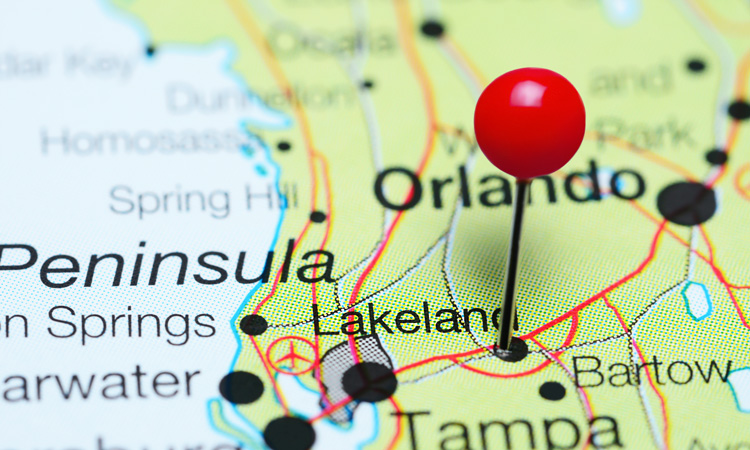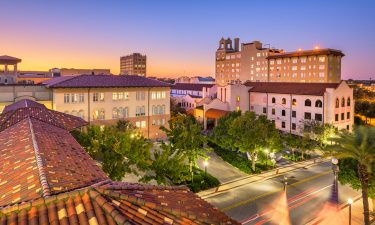City Snapshot: Lakeland – now is the time to be bold in mobility
- Like
- Digg
- Del
- Tumblr
- VKontakte
- Buffer
- Love This
- Odnoklassniki
- Meneame
- Blogger
- Amazon
- Yahoo Mail
- Gmail
- AOL
- Newsvine
- HackerNews
- Evernote
- MySpace
- Mail.ru
- Viadeo
- Line
- Comments
- Yummly
- SMS
- Viber
- Telegram
- Subscribe
- Skype
- Facebook Messenger
- Kakao
- LiveJournal
- Yammer
- Edgar
- Fintel
- Mix
- Instapaper
- Copy Link
Posted: 7 May 2020 | Angelo Rao - City of Lakeland | No comments yet
Angelo Rao, PE, Manager of Traffic Operations & Parking Services at the City of Lakeland, Florida speaks to Intelligent Transport about the challenges of advancing mobility that come with a transitioning car-centric city.


What is mobility like within the city? What challenges are you facing at the moment?
The City of Lakeland, Florida is right in the middle of Tampa and Orlando. We’re almost equidistant, 45 minutes each way between the two. Lakeland is an interesting town to me because it’s got a fabulous, older, very walkable downtown which takes you back to America of the 1930s or 1940s.
It’s also frankly a car-centric town; fortunately, in transition. There is a growing transit system, which is well run through our Citrus Connection partners, there are other local last mile mobility options, and we’re clearly moving away from this car-centric environment. We’re working together to manage the challenges of congestion, reliability of travel and safety from a pedestrian-bicycle perspective.
What is your direct role and how are you influencing what’s happening at the moment?
I’m the Manager of Traffic Operations and Parking Services, so I often say I’m the most hated man in Lakeland because I bring red lights and parking tickets to people! In truth, I’d like to think we do a little bit more than that! And as a city, we certainly do. We’re committed to maintaining and enhancing mobility, and since we’re a city that is transitioning from a car-centric city, we’re focusing on alternative options to just the car. Even some of our parking solutions, such as lower cost peripheral parking encourages walking to one’s downtown destination after parking; walk a little, save a lot!
Partnering with other City Departments and agencies, such as Police, Planning, Economic Development, and Parks, we are in essence delivering quality of life services that help create a sense of place
There’s a growing movement to create a walkable and bicycle-friendly environment. So, we’re exploring and implementing more mid-block pedestrian crosswalks, bicycle lanes, and cycle tracks; as well as expanding our downtown residential community in the order of 500 to 1,000 units within the next five years. We built our first cycle track just last year, and we’re building more roundabouts – we’re currently building our second roundabout this year.
We’re trying to change what Lakeland looks like, so that it will become more multimodal and have a different approach in terms of how people and goods move around. As a team, our primary transportation goal is achieving safety, accessibility, and mobility – most importantly – for all transportation users.
How do you strike the balance between supporting what people already know and trust, ie the car, with trying to ease congestion?
We’re fortunate to have a City Commission that genuinely understands our specific situation, as well as the wider perspective, in enhancing the multi-modal approach to transportation. It’s so important in any small to medium-sized city like Lakeland, to have that support, because they truly help by to adopting and financing these goals, with real in-the-ground results. Even though we’re a City in transition, we know that we have to blend the other modes of transportation into the mix. So, our Commission is helping us, as staff, promote multi-modalism, such as the cycle track that I mentioned earlier. That’s a big deal for Lakeland; a cycle track such as this one would have been unheard of eight or 10 years ago.
Is support of city commissions a significant challenge for other small to medium-sized cities across the United States?
Speaking honestly, if cities are not going forward in a multimodal approach, most likely it’s because either they’re not getting the legislative (City Commission) approval or support, or their own staff haven’t bought into it. The good news is that the vast majority of American cities are truly supporting and implementing multi-modal solutions, including technological solutions, particularly in their Central Business Districts.
Equally, the city’s own citizens need to be behind it. It’s important for the citizenry, the legislative branch, and the staff to be on board and engaged together to bring these progressive ideas forward.
There’s a growing movement to create a walkable and bicycle-friendly environment
One message I believe our city and our leadership has delivered on, is the notion that it’s okay to sometimes get it wrong. If you want to try something, so long as it’s reasonable and logically thought out, staff will receive the support to carefully experiment with innovative concepts, with the best interests of the citizens in mind. I think it’s important to give us that freedom to innovate, plan, and implement. A couple of examples involve red light running crash solutions and enhancing safety on a major State-owned arterial roadway in the heart of the City.


It comes down to one choice: enhance safety, accessibility, and mobility for all people
We’re also working with the Florida DOT on right-sizing (road diet) SR 37 through the middle of Lakeland. With five sub-standard lanes, the number of crashes is significant and pedestrian safety is a real concern. Working together, the FDOT has agreed to conduct a pilot project this summer, by simulating a reduction from five to three lanes. This unprecedented test in Florida at a cost of almost one million dollars, is the type of investment that is made to enhance safety and liveability.
The City Commission is willing to support us in these pilot project areas, with a view to reducing crashes and more importantly, saving lives.
Would you agree that today the transport sector is heavily tech lead in a way that it hasn’t been before?
It really is, exponential. Exponentially to the point that we can’t keep up with it. I’m sure you’ve heard of the acronym FOMO, fear of missing out. Well, what about the fear of jumping in, FOJI? If I jump in too soon, then when the next best widget comes around the corner I’m going to regret jumping in too soon, and yet if I don’t jump in, then I’m going to feel that I missed out.
How do we balance these fears? That’s a challenge that I offer out to the intelligent transportation world. We need help and guidance to know when and how to balance these fears so we can affect change positively, with minimal risks.
It sounds like the changes that you’re trying to implement are heavily based around the infrastructure rather than the services available in the city?
That is true; as engineers, infrastructure is what we know. We have to start somewhere. In the ground, solutions are practical and tend to evoke almost immediate responses by their users – good or bad!
Partnering with other City Departments and agencies, such as Police, Planning, Economic Development, and Parks, we are in essence delivering quality of life services that help create a sense of place.
Considering the trajectory of technology and innovation that we’re seeing today, will cars becoming better connected to the infrastructure around them aid mobility?
Eventually if the infrastructure changes, the actual vehicle itself, and the modal changes occur, we will have a much more established solution and a more sustainable one too.
The City Commission is willing to support us in these pilot project areas, with a view to reducing crashes and more importantly, saving lives
The main reason as to why we’re using field sensors in the red-light running problem is because we want 100 per cent of our citizens and users to be a part of the technological solutions. Eventually one could argue that we can place all of the technology into vehicles. But, with about one per cent of people having that kind of true interactive autonomous vehicle technology, I would be missing out on 99 per cent of my citizens that we are trying to help. It needs to be done in incremental steps field infrastructure first, evolving to in-vehicle services over time.
It comes down to one choice: enhance safety, accessibility, and mobility for all people. Right now, the tendency is just to put somebody behind a wheel and treat mobility in that way. However, we’re growing, we’re maturing, out of that old approach and into other more balanced modes. We need to be bold. Thankfully, the City of Lakeland is up for the challenge.
A note on COVID-19
We have developed a COVID-19 Rotational Employee Safety/Production Plan.
This plan balances the safety and production needs of our citizens with the safety of our employees. I strongly believe in the airline safety message premise of “putting one’s own oxygen mask on first”. By putting on our own oxygen masks first, we are stronger and more capable of helping others much more effectively and with confidence.
The COVID-19 Rotational Employee Safety/Production Plan has four pillars:
- Citizens are provided with the safety and production of services they deserve;
- Employees have a clear mandate of in-place production on a rotational basis;
- Employees’ safety is enhanced by practising social distancing; and
- Equitable distribution of home headquarters and office headquarters sharing for all employees is balanced and minimises costs.
The City overall is phasing-in the vast majority of operations by 18 May; and full operations by 1 June.
Biography
With a combined 40 years of public and private sector service, Angelo understands the special needs of the public. He has personally attended and/or chaired over 600 public meetings with a view of reaching consensus within these communities for implementing lasting solutions for all transportation users.
Related topics
Fleet Management & Maintenance, Infrastructure & Urban Planning, Intelligent Transport Systems (ITS), Traffic Management, Transport Governance & Policy, Vehicle & Passenger Safety
Related modes
Car
Related cities
Florida
Related organisations
City of Lakeland








